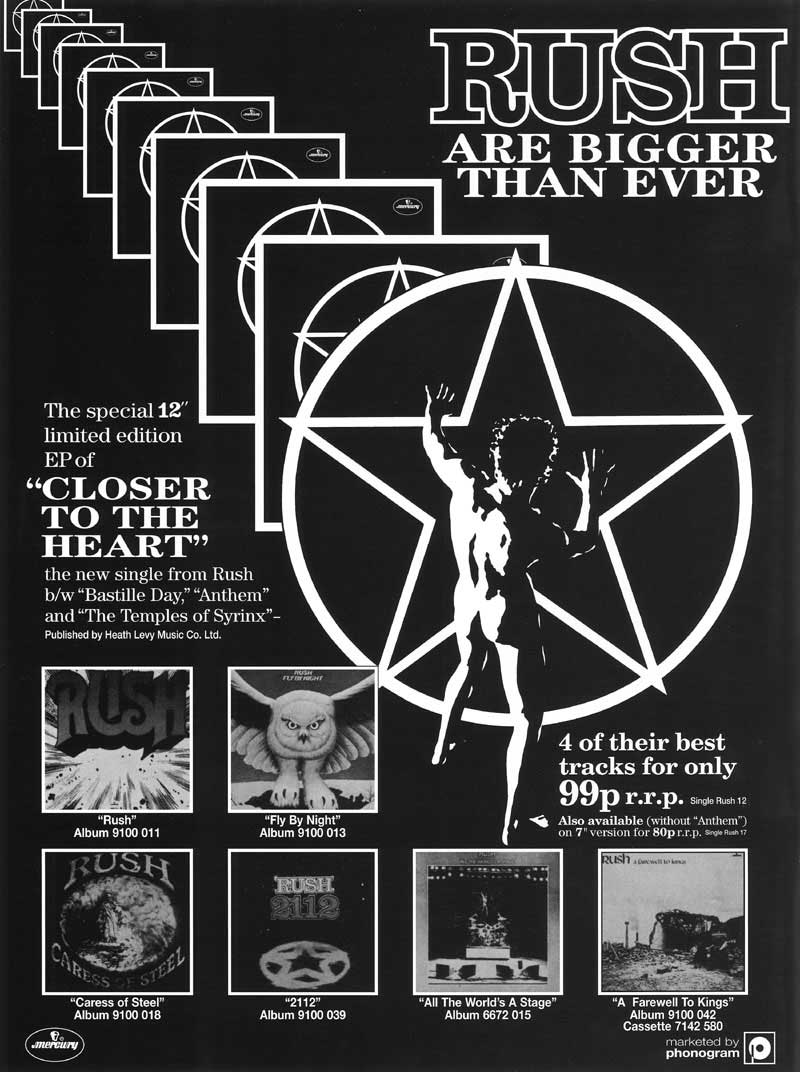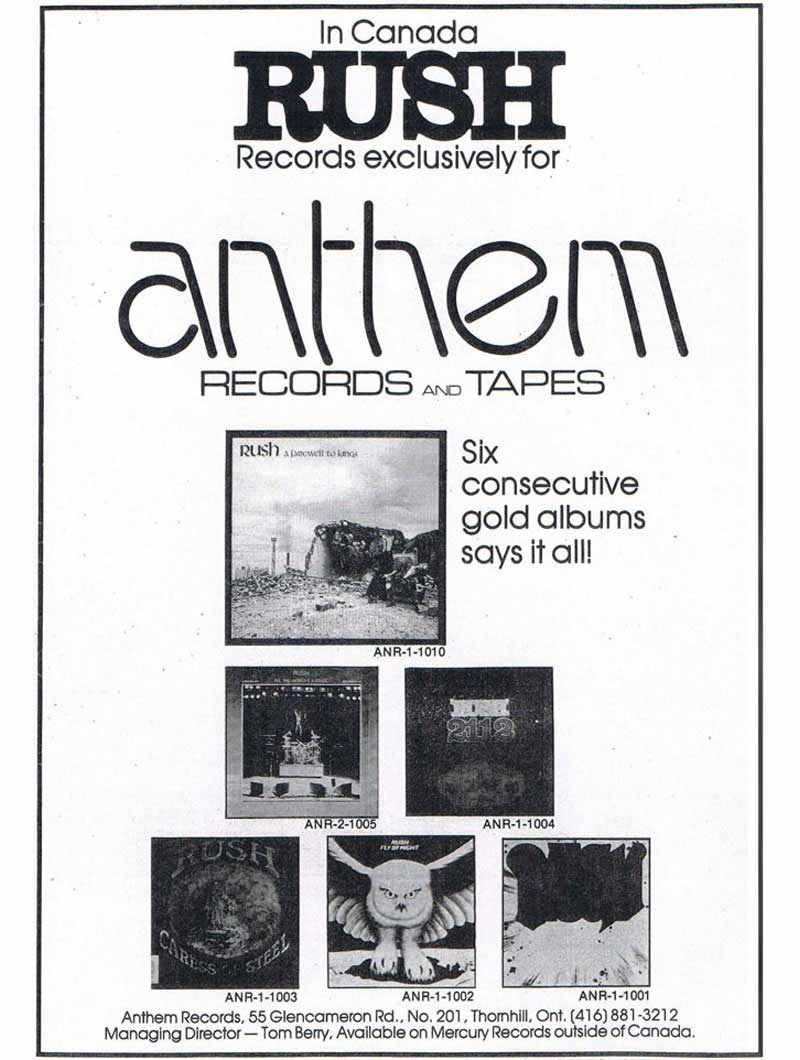
- A Farewell to Kings (5:51)
- Xanadu (11:08)
- Closer To The Heart (2:53)
- Cinderella Man (4:22)
- Madrigal (2:35)
- Cygnus X-1 Book I: The Voyage (10:25)
- Prologue (5:01)
- 1 (0:45)
- 2 (1:34)
- 3 (3:05)
Neil Peart - Drums, orchestra bells, tubular bells, temple blocks, cowbells, wind chimes, bell tree, triangle, vibra-slap
Geddy Lee - Bass guitar, twelve string guitar, Mini Moog, bass pedal synthesizer, vocals
Alex Lifeson - Six and twelve string electric guitar, six and twelve string acoustic guitar, classical guitar, bass pedal synthesizer
Produced by Rush and Terry Brown
Recorded at Rockfield Studios, Wales, June 1977
Engineered by Pat Moran and Terry Brown (Broon)
Mixed at Advision Studios, London
Engineered by Terry Brown, Assisted by Declan (not Norman!) O'Doherty and Ken Thomas
Art direction and graphics by Hugh Syme
Cover photography by Yosh Inouye
Sleeve photography by Roger Stowell
Liner photographs by Fin Costello
Design assistance by Bob King
Mastered at JAMF, Toronto by George Graves
Management by Ray Danniels, SRO Management, Inc., Toronto
Executive Production-Moon Records
Roadmaster and lighting director-Howard (Herns) Ungerleider
Concert sound engineer and effects consultant-Major Ian Grandy
Stage right technician-Liam (Elfbjörn) Birt
Stage left technician-Skip (Slider) Gildersleeve
Centre stage technician-Larry (The Saint) Allen
Stage Manager-Mike (Lurch) Hirsh Chauffeur extraordinaire-(Ms.) Jorge Hoadley
Hello and thank you to National Sound and Crew, See Factor Lighting and Crew (U.K. too!), Electrosound U.K. and Crew, Graham The Coach Driver, Alans Moore and Kearsley, all at Rockfield and Pat (Duffo) Moran, (Farewell to Kingsley), Max Websters' Dancing and Crew, the Cult and Crew, Fabrissio, The Percussion Centre, Tony (Old School Thai) Kelly, Continental Tom Berry, and all our friends in the U.K. (and everywhere!) we remember Brooklyn.
A special thank you to Dirk, Lerxst, and Pratt.
Our thanks also go out to the good people of Gibson Guitars, Rickenbacker Guitars, and Slingerland Drums for their personal help and consideration.
Dedicated to Nancy, Charlene, and Jacqueline
© 1977 Mercury Records © 1977 Anthem Entertainment
Notes
- Mercury/Polygram, August 29, 1977
- Highest Billboard Chart Position: 33 - Certified Gold by RIAA: November 16, 1977 - Certified Platinum: December 1, 1993
- Reissued April 21, 2015 by Universal Music Enterprises on 200-gram, heavyweight vinyl with a download code for a 320kbps MP4 vinyl ripped Digital Audio album as well as high resolution Digital Audio editions in DSD (2.8mHz), 192khz / 24-bit, 96kHz / 24-bit; and an additional Blu-Ray Pure Audio version with 96kHz / 24-bit 5.1 surround sound and stereo.
- To celebrate A Farewell to Kings' 40th Anniversary, UMe/Anthem/ole released two different Record Store Day singles in 2017. On April 22, a 5000 copy limited edition 12" single of Cygnus X-1 (Books I and II) on 180g vinyl featuring "Book I: The Voyage" backed by "Book II: Hemispheres" on side B. The following November 24th, a 5000 copy limited edition 7" single of Closer To The Heart backed by Madrigal was released. And of course the A Farewell to Kings 40th Anniversary Edition was released on December 1, 2017. All these items include new artwork from Hugh Syme.




In Their Own Words
"We recorded the intro to 'A Farewell to Kings' outside in the courtyard at Rockfield Studios on a rare sunny day in Wales. We put up a couple mics so we could make a simple stereo recording. Neil had a little percussion area of bells and not congas, but what we used to call 'knuckleheads.' Geddy set up a keyboard, and I had the Ramirez. You can hear the guitar move across the stereo field as I walk around the courtyard on the gravel while we play. So that one was recorded live not off the floor but off the stones. We cut the intro outside and then headed inside to cut the main track on electric. That's the way we envisioned it. We wanted that contrast of something very pure and acoustic." - Alex Lifeson, Guiar Player, September 2018
"We tried to rehearse 'A Farewell To Kings' on the last tour [Snakes & Arrows] and I couldn't successfully sing that without hurting myself, so we gave up. So yeah, there are moments of the past I cannot sing anymore." - Geddy Lee, Blender, April 2009
"The first one we started was 'Closer to the Heart'... [It] is a bit different from any song we've done. It was based on somebody else's idea. It came from Peter Talbot. He's a radio and media person and a very prolific writer, so every time we get out there he gives me a big pile of stuff like this to take home. 'Closer to the Heart,' the title and the first verse, comes from him." - Neil Peart, Circus, October 13, 1977
"Geddy's bass playing is so melodic and that comes from playing bass parts on an acoustic guitar. He would play bass lines right on the acoustic, but he would come up with a lot of guitar parts too. 'Closer to the Heart' for instance...he wrote that opening picking part. I heard it and said, 'That's so cool-show me that!'" - Alex Lifeson, Frets, Spring 2006
"All of our early albums were written on acoustic guitar. When Geddy and I would write the music, we'd sit down with a cassette recorder and two acoustic guitars, in spite of the fact that we were a hard rock band. 'Closer to the Heart' is a sweet, ballady type of song, but we mix it up. It takes an interesting course as the arrangement builds. Once we got the basic arrangement down, we knew that the intro would be acoustic, and then we took it up a notch dynamically and brought the whole band in. The 12-string intro gives it the illusion of being an acoustic piece, and then the rhythm section comes in and the song changes into a kickin' rock tune." - Alex Lifeson, GuitarWorld.com, April 30, 2015
"With 'Xanadu', we ran that down once to get the sound and levels, and then we hit 'record' and played the song and it was done. Pat Moran, the engineer on that record, was shocked. Seldom did a rock band do one take of a song that's eleven minutes long. He was blown away." - Alex Lifeson, ClassicRock.com, May 2015
"With 'Xanadu', even though it's loosely based on Coleridge's Kubla Khan, it's also very influenced by Citizen Kane. If you look at the opening of the newsreel of Citizen Kane, they quote that poem: [he adopts the opening tone of the original voiceover] 'In Xanadu the pleasure dome did decree...' and that whole sort of animated opening to that, so I kept that in mind when we created the soundscape to the opening of that song. I always had that visual in my brain as we were making the music, I always had a connection to that whole thing. They're intertwined for me." - Geddy Lee, Prog, December 2017
"We brought 'Xanadu' back into the live set on the Presto tour and I was surprised how well it went down. It was one of those forgotten songs that was fun to play again so I think we'll keep it around for a while - recycle it!" - Geddy Lee, The Guitar Magazine, November 1993
"['Cinderella Man'] was inspired by one of my favourite movies, the original Mr. Deeds Goes To Town, where he's referred to as a Cinderella man. I was a big film guy as a teenager, and as a young man, I was really a film buff - I watched films all the time. I studied directors because I sort of secretly wanted to be a film director. It was just one of those dreams for when I grow up. And when I realised that most directors have to be part megalomaniac, I think I sort of went off that idea. But I loved film, I still do. The old films, my wife and I used to watch them all the time together, and so the Capra movies were big with me - lot of heart, lot of soul, lot of showing the best and worst of America and its people. So that song is really just about that movie and the kind of themes that movie resonated with. It was my thing that I brought in and Neil helped me clean it up a bit. One thing in Rush is that we've always allowed ourselves to go where we want to go as individuals and see it how flies. We all have to be behind it to use it. But there were no real boundaries in our band." - Geddy Lee, PROG #82, December 2017
"There's one science fiction epic on the album called 'Cygnus X-1' and the root for that came from Time magazine. I was reading Time magazine and they were talking about black holes and their approximate origin and I built a song around it." - Neil Peart, Circus, October 13, 1977
"I saw Rush play Xanadu live at their first ever UK gig. This was at the Sheffield City Hall back in 1977. It was the solitary new song they played on that tour, and as I already had the live album All The World's A Stage, which is pretty much what they played, the only thing I wasn't familiar with. But it stood out as an epic piece. It's 11 minutes long and musically meandering from quiet to very loud all the way through... Amazing stuff." - Joe Elliot (Def Leppard), PROG, Issue 52 January 2015
Promos
Smartphone Wallpaper
Our RUSH smartphone wallpapers have been modified for a 9:19.5 aspect ratio to fit "most" Smartphones.

This is a collection of transcripts of magazine and newspaper articles and other media related to this release or coinciding with the time frame surrounding it. This is an ongoing work in progress; feel free to email any suggested additions.












